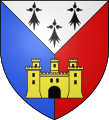Drawbar (heraldry)
The drawbar or fork , rarely cart Lanne is in the Heraldry both a Herold image as well as a common figure , and has the shape shown in a pole strength, strong symbolized Wye .
Representation and blazon
The arms of this Y-like cross run from the post in the shape of a fork at an angle upwards and outwards into the upper corners of the shield.
The counterpart is called Göpel . In many other languages, unlike in German, which she sees as two independent images, the Deichsel (French and Portuguese pairle , English pall , Spanish perla , Italian pergola ) is the main character, the Göpel as its inverse (French pairle inversé , English pall reversed , span./port. perla / pairle invertida , Italian pergola rovesciata ).
As a herald image and shield division (drawbar section)
As a heraldic image , all three bars (arms) must touch the edge of the shield . This shape divides the (monochrome) shield into three fields, one between the Y-arms and another field on each side. In the blazon , the upper field is addressed first, then the front ( heraldically right , left as seen from the viewer) and finally the rear.
Similar to other Herald pictures, there is also a shield division in the drawbar section , in which the three fields directly adjoin one another, with no “visible” drawbar. The drawbar (and accordingly the Göpel) is perceived as a variant of the division , in the blazon it then reads: In the drawbar cut (or fork cut ) divided by… . Another way of saying French / English is: tiercé en pairle / tierced pallwise (' thirds ').
In addition, with the herald's image on the sign, one says divided by a [color] drawbar ... then a drawbar lies exactly at the drawbar cut, or around the drawbar all three fields (or at least two) different colors.
As a mean figure
The drawbar also appears as a mean figure . In doing so, it must not touch the edge of the shield. In the shield (field) it resembles a floating Ypsilon, it must then be reported as floating , or is called a forked cross , like the Y or Ψ-shaped forked cross (Schächerkreuz) .
variants
The width is possible from that of the post (beam) to the thread . The upper arms can also be bent or flexed be what needs to be reported. The two upper arms can also touch the edge of the blade below the upper edge, then the drawbar is lowered (reduced) . The cut edges can accept all heraldic cuts, but are limited to straight and wavy cuts . With the appropriate width of the Göpel as other heraldic elements may busy or rimmed be.
In most cases the floating drawbar is very sleek , that is, the ends of which form right-angled cutting edges. If they run to a point, this must be reported as a pointed drawbar . Other final shapes are also possible.
A drawbar () overlaid by a pole is called a pole drawbar or gusset (not to be confused with the curled point , which is sometimes also called that). The drawbar can be connected to the shield base , from which the shield base drawbar is created, and the shield base post drawbar with an overlaid post .
If the drawbar post is particularly wide and the upper field between the arms is the same color, i.e. a Y-shaped section filled with the same color, it is called a fork .
use
Drawbar and Göpel cuts are comparatively rare. They are considered heraldically problematic: there is an intersection of three lines, three fields meet, so they cannot be filled according to the heraldic color rule , two metals or two colors always collide. But because the herald's image is outdated, the break is tolerated. The other options are to touch the fields equally on both sides, or to cover the cut with the drawbar, that is, only colors on the sign and the drawbar in gold or silver, or vice versa.
A special use is for the representation of the pallium , one of the Pope's official badges. The lower end, fringed like the church flag, is typical .
Blue and especially wavy, the drawbar often represents confluences where a place is located. Accordingly, it can also symbolize forks in the road.
Examples
In blue a silver pole, with three roses covered ( Somerniemi FI)
Divided in the drawbar cut [a shield] by ermine, blue and red ( Kerlaz FR)
Divided humiliated by a silver drawbar ( Croisy-sur-Andelle FR)
Divided by a bar bordered drawbar ( South Africa , flag)
Blue shaft drawbar ( Warmensteinach DE)
Pierced fork
Black Levitating Pointed Drawbar ( Cunningham )
Web links
- Bernhard Peter: Combinations of incomplete dividing lines: Göpel and drawbar












